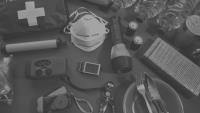 Add My Company
Add My Company
Sign In
Tendon and Ligament injuries explained
11-09-2023

When it comes to tendon and ligament injuries, the two injuries are very alike. This often causes a confusing overlap between the two. A simple way to distinguish between the two is that a tendon attaches a muscle to bone whereas a ligament attaches bone to bone.
However, both injuries still have similar symptoms, and this is what causes confusion for most people when trying to distinguish between the two.
These two injuries also often get mixed up because both ligaments and tendons are made up of connective tissue called collagen fibres. Nevertheless, how this collagen is formed together is very different in each.
In tendons the fibres are parallel, allowing for more elasticity. Which, if you think about the way muscles expand and contract, makes them more suited to connecting the muscle to the bone.
The fibres in ligaments however follow a crisscross pattern. This helps to keep the ligament stable and ultimately supports, stabilises and strengthens the bone joints.
So, in order to understand these injuries better and learn how to treat them, you need a better understanding of the injuries themselves.
Ligament Injuries
Although ligaments are strong and rigid by nature, sudden forces and strains can cause tears and ruptures, this damage occurs when the fibres are torn. Because of the lack of blood supply to the tissue, sometimes tears become permanent.
If a ligament is stretched past a certain point, it can result in the ligament unfortunately never returning to its original state.
An Anterior Cruciate Ligament (ACL) tear is the most common sport-related injury to the ligament, learn all you need to know about ACL tears here.
Ligament injuries can be treated through the use of a knee brace or support, however, depending on the severity of the injury if your planned activity has the potential to place a high amount of stress on the knee, then a high supporting knee brace such as the Donjoy Armor with Fourcepoint would be suitable.
Tendon Injuries
Similarly, if overstrained tendons can become damaged and even snap.
A partially torn tendon will cause swelling and discomfort but can be healed over time. Whereas a complete tear will cause a complete loss of movement and potentially permanent damage.
A common tendon injury that athletes suffer is damage to the Achilles tendon, which connects the heel to the muscle in your lower leg. This injury is most commonly caused by overstraining or improper footwear.
Achilles tendon can best be prevented by warming up sufficiently before any vigorous activity. Additionally, wearing supports designed specifically for the area will aid in prevention.
Tendonitis is another common injury which sees inflammation and swelling of the tendon. This can generate pain and stiffness and will be most likely caused by straining of the tendon.
The best treatment for an injured tendon would be to use an ice pack immediately to reduce the swelling, whilst keeping the injured area elevated.
If there is any serious damage or possible tears, the injury may require a splint in order to aid the healing process. Alongside using taping and strapping to help stabilise the area.
Distinguishing Between Ligament & Tendon Injuries
It can be very difficult to distinguish between a ligament and a tendon injury on the field. The best way to get a definite answer would be to seek medical advice by visiting your doctor, who may offer you an X-ray.
The key thing to remember is to not leave any injury untreated, this helps to prevent any further possible damage. This can be done through a range of products such as supports and braces, taping and strapping and cold therapy treatments. Or, of course, visiting the local doctor for more guidance.
Additionally, planning out your warm-up and cool-down techniques and potentially working with a physiotherapist during rehabilitation are both methods to prevent a recurrence of the injury.
For more information on Tendon and Ligament injuries explained talk to ABC Training Services Ltd
Enquire Now
List your company on FindTheNeedle.

